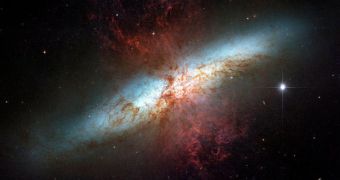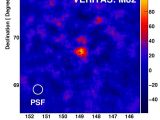Astronomers using the Very Energetic Radiation Imaging Telescope Array System (VERITAS), in Amado, Arizona, have recently announced that they discovered very high energy (VHE) gamma-ray emissions coming in from the starburst galaxy M82, also known as the Cigar Galaxy. According to the team, the radiations are very powerful, and their photons have energies more than a trillion times higher than those in visible light. The find holds the potential of clearing up a number of mysteries related to the early Universe, the US National Science Foundation (NSF) reports.
The VHE GRB are the most energetic ones discovered as coming from a galaxy that is also involved in forming massive amounts of new, blue stars. The new discovery relies on an observation campaign that lasted more than 224 months, the team writes in a new study, scheduled for publication online tomorrow, November 4, in the print version of the acclaimed scientific journal Nature. “This is the first example of a very-high-energy gamma-ray source associated with a starburst galaxy, and its discovery provides fundamental insight into the origin of cosmic rays,” University of California in Los Angeles (UCLA) Physics Professor Rene Ong says. He is also a VERITAS spokesperson.
“Our program has been supporting studies of VHE gamma-rays and cosmic rays in separate and very different experiments for over a decade. This significant VERITAS discovery provides an immediate connection between the sources of these two types of very energetic particles and enhances our understanding of the early Universe,” the NSF Division of Physics Program Director for Particle and Nuclear Astrophysics Jim Whitmore says. The origins of gamma-ray bursts remain somewhat of a mystery even now, more than 100 years after they were first discovered.
The new study is one of the clearest pieces of evidence to date to support the theory that states that supernovae and massive star winds are the main elements that accelerate particles in the vastness of space. These structures, in effect, act like very powerful particle accelerators. “Starburst” galaxies are thus expected to have a higher number of cosmic rays per unit volume, because they are very likely to contain massive numbers of massive stars and supernovae. According to the VERITAS readings, M82 has a gamma-ray radiation reading that is 500 times that recorded in our own Milky Way.
“We knew that the detection of M82 would have important scientific implications. As a result, we scheduled an exceptionally deep exposure immediately after the experiment became fully operational. The data took almost two years to acquire, and needed to be meticulously analyzed to extract the gamma-ray signal which is over 1 million times smaller than the background noise. Although the signal is only a tiny fraction of the data, we made many checks for possible bias and we are confident that the signal is genuine,” Smithsonian Astrophysical Observatory (SAO) astrophysicist Wystan Benbow says. The expert has also been the coordinator of the new VERITAS project.

 14 DAY TRIAL //
14 DAY TRIAL // 

